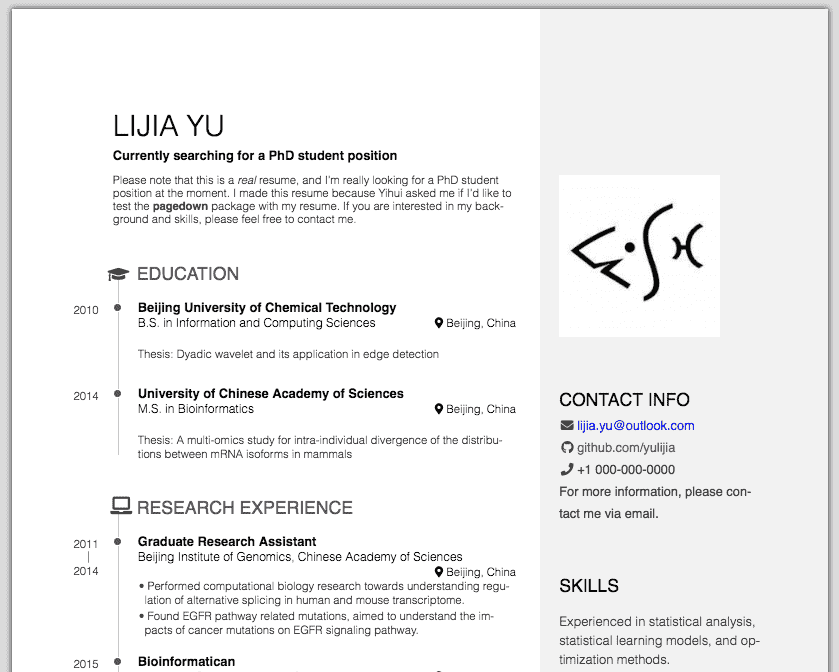
Troubleshooting R Markdown documents can be challenging because you are no longer in an interactive R environment, and you will need to learn some new tricks. This makes it easier to understand the dependson specification. I’ve used the advice of David Robinson to name these chunks: each chunk is named after the primary object that it creates. Rawdata <- readr::read_csv("a_very_large_file.csv")Īs your caching strategies get progressively more complicated, it’s a good idea to regularly clear out all your caches with knitr::clean_cache(). For example, here the processed_data chunk depends on the raw_data chunk: ```
#Rmarkdown resume code
The caching system must be used with care, because by default it is based on the code only, not its dependencies. On subsequent runs, knitr will check to see if the code has changed, and if it hasn’t, it will reuse the cached results. When set, this will save the output of the chunk to a specially named file on disk. However, it can be painful if you have some computations that take a long time. This is great for reproducibility, because it ensures that you’ve captured every important computation in code. Normally, each knit of a document starts from a completely clean slate. The following table summarises which types of output each option suppresses:

Knitting to fail if there is a single error in the document. It’s also useful if you’re teaching RĪnd want to deliberately include an error. Of your report, but can be very useful if you need to debug exactly This is rarely something you’ll want to include in the final version Results = 'hide' hides printed output fig.show = 'hide' hidesĮrror = TRUE causes the render to continue even if code returns an error. Message = FALSE or warning = FALSE prevents messages or warnings

Use this when writing reports aimed at people who don’t Use this for setup code that you don’t wantĮcho = FALSE prevents code, but not the results from appearing in theįinished file. Include = FALSE runs the code, but doesn’t show the code or results This is useful forĭisplaying example code, or for disabling a large block of code without (And obviously if theĬode is not run, no results will be generated). The most important set of options controls if your code block is executed and what results are inserted in the finished report:Įval = FALSE prevents code from being evaluated. Here we’ll cover the most important chunk options that you’ll use frequently. Knitr provides almost 60 options that you can use to customize your code chunks. If you forget, you can get to a handy reference sheet with Help > Markdown Quick Reference.Ĭhunk output can be customised with options, arguments supplied to chunk header. It will take a few days, but soon they will become second nature, and you won’t need to think about them. The best way to learn these is simply to try them out. The numbers are incremented automatically in the output.
#Rmarkdown resume how to
The guide below shows how to use Pandoc’s Markdown, a slightly extended version of Markdown that R Markdown understands. Markdown is designed to be easy to read and easy to write. Rmd files is written in Markdown, a lightweight set of conventions for formatting plain text files. RStudio executes the code and displays the results inline with the code: You can run each code chunk by clicking the Run icon (it looks like a play button at the top of the chunk), or by pressing Cmd/Ctrl + Shift + Enter. Rmd, you get a notebook interface where code and output are interleaved.

This means that help is, by-and-large, not available through ?. R Markdown integrates a number of R packages and external tools. Notebook where you can capture not only what you did, but also what you R Markdown files are designed to be used in three ways:įor communicating to decision makers, who want to focus on the conclusions,įor collaborating with other data scientists (including future you!), whoĪre interested in both your conclusions, and how you reached them (i.e.Īs an environment in which to do data science, as a modern day lab R Markdown documents are fully reproducible and support dozens of output formats, like PDFs, Word files, slideshows, and more.

R Markdown provides an unified authoring framework for data science, combining your code, its results, and your prose commentary.


 0 kommentar(er)
0 kommentar(er)
